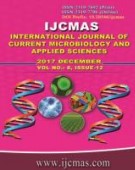


 National Academy of Agricultural Sciences (NAAS)
National Academy of Agricultural Sciences (NAAS)

|
PRINT ISSN : 2319-7692
Online ISSN : 2319-7706 Issues : 12 per year Publisher : Excellent Publishers Email : editorijcmas@gmail.com / submit@ijcmas.com Editor-in-chief: Dr.M.Prakash Index Copernicus ICV 2018: 95.39 NAAS RATING 2020: 5.38 |
Present investigation was performed to elucidate the role of selected plant antioxidant enzymes (lipoxygenase and nitrate reductase) and phenolic compounds (total phenol and condensed tannin) in imparting the resistance/susceptibility to aphid infestation in two cotton genotypes (CPD14-1 and CPD14-2). Leaf samples were collected from both aphid infected as well as uninfected plants at 45, 85 and 125DAS (days after sowing) and analysis of the phenolic compounds and enzymatic activities were carried out. Changes in the enzyme activity level were determined at different time interval after infestation. The results indicated that aphid infestation increased the total phenols, condensed tannin, and enzymatic activities. The resistant genotype CPD14-1 recorded higher phenol content (7.07g/100g dry weight), condensed tannin (7.97g/100g dry weight) and enzymatic activities lipoxygenase (3.42U/mg of protein) and nitrate reductase (62.6 nmoles of NO2 g/h) than susceptible genotype CPD14-2. The results suggested that enhanced activities of enzymes and phenolic compounds may contribute bioprotection of cotton plants against aphid infestation.
 |
 |
 |
 |
 |